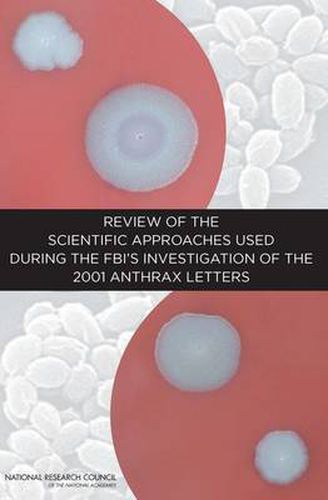Readings Newsletter
Become a Readings Member to make your shopping experience even easier.
Sign in or sign up for free!
You’re not far away from qualifying for FREE standard shipping within Australia
You’ve qualified for FREE standard shipping within Australia
The cart is loading…






Less than a month after the September 11, 2001 attacks, letters containing spores of anthrax bacteria (Bacillus anthracis, or B. anthracis) were sent through the U.S. mail. Between October 4 and November 20, 2001, 22 individuals developed anthrax; 5 of the cases were fatal. During its investigation of the anthrax mailings, the FBI worked with other federal agencies to coordinate and conduct scientific analyses of the anthrax letter spore powders, environmental samples, clinical samples, and samples collected from laboratories that might have been the source of the letter-associated spores. The agency relied on external experts, including some who had developed tests to differentiate among strains of B. anthracis. In 2008, seven years into the investigation, the FBI asked the National Research Council (NRC) of the National Academy of Sciences (NAS) to conduct an independent review of the scientific approaches used during the investigation of the 2001 B. anthracis mailings. Review of the Scientific Approaches Used During the FBI’s Investigation of the Anthrax Letters evaluates the scientific foundation for the techniques used by the FBI to determine whether these techniques met appropriate standards for scientific reliability and for use in forensic validation, and whether the FBI reached appropriate scientific conclusions from its use of these techniques. This report reviews and assesses scientific evidence considered in connection with the 2001 Bacillus anthracis mailings.
$9.00 standard shipping within Australia
FREE standard shipping within Australia for orders over $100.00
Express & International shipping calculated at checkout
Less than a month after the September 11, 2001 attacks, letters containing spores of anthrax bacteria (Bacillus anthracis, or B. anthracis) were sent through the U.S. mail. Between October 4 and November 20, 2001, 22 individuals developed anthrax; 5 of the cases were fatal. During its investigation of the anthrax mailings, the FBI worked with other federal agencies to coordinate and conduct scientific analyses of the anthrax letter spore powders, environmental samples, clinical samples, and samples collected from laboratories that might have been the source of the letter-associated spores. The agency relied on external experts, including some who had developed tests to differentiate among strains of B. anthracis. In 2008, seven years into the investigation, the FBI asked the National Research Council (NRC) of the National Academy of Sciences (NAS) to conduct an independent review of the scientific approaches used during the investigation of the 2001 B. anthracis mailings. Review of the Scientific Approaches Used During the FBI’s Investigation of the Anthrax Letters evaluates the scientific foundation for the techniques used by the FBI to determine whether these techniques met appropriate standards for scientific reliability and for use in forensic validation, and whether the FBI reached appropriate scientific conclusions from its use of these techniques. This report reviews and assesses scientific evidence considered in connection with the 2001 Bacillus anthracis mailings.